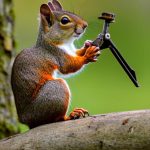Your cart is currently empty!

The Top 7 Best Ways to Hunt Squirrels

Are you eager to ramp up your bushytail count this season, but find those sly little critters always seem to dodge your best efforts? You’re certainly in good company. Many hunters grapple with the challenge of outsmarting these nimble tree-dwellers, often returning from a day’s excursion through the woods without a single tail to show for it.
We’ve felt that same frustration, puzzling over why our tried-and-true methods were falling short.
Fear not, we’ve taken a deep dive into the squirrel hunting playbook and returned with strategies that pack a punch. Did you realize that sometimes all it takes is settling into just the right spot and letting patience work its magic? We’ll walk you through every step—choosing the perfect firearm or bow, refining those stealth approaches—and even dish out some wisdom on when silence can be golden.
Our arsenal of tips is designed to level up your game whether your hunt includes man’s best friend at your side or if you thrive as a lone ranger under the canopy.
So gear up for an article chock-full of trade secrets that cater to both eager greenhorns itching for their first taste of success and grizzled veterans seeking to hone their craft even further.
It’s high time we turn you into an ace squirrel hunter! Let’s set sights on taking your skills from hit-or-miss to expert sharpshooter status in no time.
Key Takeaways
- To hunt squirrels, use still hunting by moving quietly and stand hunting by waiting in a good spot.
- The right gear is important. Choose a shotgun for close range, .22 rifle for distance, or bow for silence.
- Try tracking squirrels with dogs if you train them well and keep everyone safe.
- Learn to find where squirrels eat and play. Hickory trees are great spots in early fall.
- Always follow local laws when hunting. Get the right license and know the season rules.
Squirrel Hunting Basics
When it comes to squirrel hunting, there are two main methods – still hunting and stand hunting. Each method requires different techniques and strategies, as well as the necessary gear and licenses.
Let’s dive into the basics of squirrel hunting to set the foundation for a successful hunt.
Two main methods: still hunting and stand hunting
We know getting squirrels can be tricky. They’re fast and alert, so we’ve got to be smart about how we hunt them.
- Move quietly through the woods.
- Look for signs like chewed nuts or squirrel chatter.
- Take slow steps.
- Stop often and listen.
- Watch for movement in the trees and on the ground.
- Stay patient, as squirrels will return even if spooked.
- Find a good spot near squirrel activity.
- Sit down and blend in with your surroundings.
- Keep your eyes peeled on areas with lots of nuts or nests.
- Wait quietly, without making sudden moves.
- Use binoculars to spot squirrels from afar.
- Be ready to take a shot when a squirrel comes into view.
Necessary gear and licenses
To hunt squirrels, we need specific gear and licenses. Here’s what you’ll need:
- Hunting License: Ensure you have a valid small game hunting license for the state or area where you plan to hunt.
- Proper Weapon: Choose a suitable weapon such as a shotgun, .22 caliber rifle, or bow, considering factors like accuracy and ease of maneuvering in wooded areas.
- Clothing: Wear camouflage or earth-tone clothing that blends with the natural surroundings to avoid being detected by squirrels.
- Binoculars: Carry binoculars to spot squirrels from a distance and plan your approach carefully.
- Calls and Decoys: Using squirrel calls and decoys can attract squirrels within range for a successful hunt.
- Safety Equipment: Don’t forget essential safety gear like eye and ear protection.
- Tools for Field Dressing: Carry tools for field dressing your catch to prepare it for consumption later on.
Choosing the Right Weapon
When it comes to selecting the right weapon for squirrel hunting, there are a few options to consider. Shotguns, .22 caliber rifles, and bows each have their own advantages and factors to take into account when making your decision.
Shotgun, .22 caliber rifle, or bow
When choosing the right weapon for squirrel hunting, considering a shotgun, .22 caliber rifle, or bow is crucial. Each has its own advantages and suitability for different situations:
- Shotgun:
- Ideal for close – range hunting in dense wooded areas.
- Offers a wider spread pattern which increases chances of hitting a moving target.
- .22 caliber rifle:
- Suited for longer range shooting and accuracy.
- Provides a quieter option for hunting squirrels without spooking other wildlife.
- Bow:
- Requires precision and skill but offers a silent approach to hunting.
- Popular among hunters looking for a challenge or those interested in traditional archery.
Factors to consider
When choosing the right weapon for squirrel hunting, there are several important factors to consider:
- Consider the density of the hunting area and the typical distance of your shots.
- Think about your level of comfort and experience with each type of weapon.
- Take into account the local regulations regarding hunting weapons and their specific use for squirrel hunting.
- Keep in mind the time of year you plan to hunt, as well as any seasonal variations in squirrel behavior and habitat.
Tracking and Stalking Techniques
To effectively track and stalk squirrels, it’s crucial to move slowly and quietly through the woods while staying aware of your surroundings. Use natural obstacles like bushes, trees, and terrain changes to your advantage as you search for squirrels.
Go slow and be aware of surroundings
As hunters, we understand the importance of moving slowly and being mindful of our surroundings when squirrel hunting. This tactic allows us to spot squirrels and their movements more easily, increasing our chances of a successful hunt.
Staying aware also helps us avoid spooking the squirrels, giving us an advantage in getting closer for an accurate shot.
When navigating through the woods, it’s crucial to take deliberate steps and scan the area carefully for any signs of movement or rustling in the trees. By maintaining this cautious approach, we can position ourselves strategically without alerting the squirrels to our presence.
Slowly maneuvering through the hunting ground heightens our awareness while creating opportunities for a precise shot when a squirrel comes into view.
By being attuned to our surroundings and moving cautiously, we enhance our ability to locate and target squirrels effectively during each hunting excursion. Tracking these critters requires meticulous attention as they often blend seamlessly into their environment – making it imperative that hunters move with deliberate care.
Use natural obstacles to your advantage
Utilize natural obstacles like trees and rocks to approach squirrels without being noticed. Stay low and move quietly to blend in with the surroundings. Hickory trees are great places for high stands, giving you a vantage point while camouflaging against the tree’s bark.
Use this technique in early fall when squirrels are actively foraging near hickory trees, helping you to get within shooting range without spooking them.
When utilizing natural obstacles to your advantage, it’s important to remember that patience is key. By strategically positioning yourself near these obstacles, you can increase your chances of a successful hunt while minimizing the risk of scaring off squirrels prematurely.
Hunting with Dogs
Hunting with dogs can be a valuable asset for squirrel hunting. Their keen sense of smell and ability to track can make it easier to locate squirrels in the woods. Proper training and safety measures are important when hunting with dogs.
Benefits and tips
Here are some benefits and tips for hunting with dogs:
- Dogs can help track squirrels by scent, making it easier to locate them in dense woods.
- They can also flush out squirrels from their hiding spots, increasing your chances of a successful hunt.
- Proper training is essential to ensure that the dog doesn’t scare off the squirrels or disrupt the hunting process.
- Maintaining safety measures such as using bright collars and ensuring good behavior around firearms is crucial when hunting with dogs.
- Utilizing a well – trained dog can add an element of excitement and teamwork to your squirrel hunting experience.
- Be aware of local regulations regarding hunting with dogs, as there may be specific rules and seasons for this method.
- When done correctly, hunting with dogs can enhance the overall efficiency and enjoyment of your squirrel hunting expedition.
Proper training and safety measures
When hunting for squirrels, ensuring proper training and safety measures is crucial for a successful and responsible hunt. Here are key measures to consider:
- Familiarize yourself and others in your hunting party with firearm safety rules and proper handling techniques.
- Ensure that all members of the hunting party have completed any required hunter education or firearms safety courses before venturing into the field.
- Use appropriate protective gear, including eye and ear protection, to safeguard against potential hazards during the hunt.
- Always maintain clear communication with fellow hunters to prevent accidents and ensure a coordinated approach during the hunt.
- Regularly review local hunting regulations and laws to stay updated on any changes or specific requirements in your area.
- Before heading out, inform someone about your hunting plans, including your intended location and expected return time, as an additional safety precaution.
- Practice ethical hunting behavior by respecting wildlife, adhering to bag limits, and promoting responsible stewardship of natural resources.
Other Squirrel Hunting Methods
Active hunting techniques involve actively pursuing squirrels by walking through the woods and using calls to attract them. On the other hand, passive hunting techniques involve finding a good spot to sit and wait for squirrels to come within shooting range.
These methods require different strategies and patience, so it’s important to choose the right one for your hunting environment.
Active hunting techniques
To hunt squirrels actively, we can employ some effective techniques. Here are the methods:
- Utilize spot-and-stalk hunting by carefully scanning the area and moving quietly to locate squirrels.
- Engage in still – hunting by slowly advancing and stopping frequently to observe for any movement or sound.
- Take advantage of natural obstacles such as trees and bushes to conceal your movements and approach squirrels stealthily.
- Practice patience and maintain a keen awareness of your surroundings to anticipate squirrel activity.
- Make use of calls or baits to attract squirrels, increasing the chances of encountering them during an active hunt.
Passive hunting techniques
After discussing active hunting techniques, we can explore passive hunting techniques used for hunting squirrels. Here are some effective passive hunting techniques to consider:
- Utilize tree stands or ground blinds to remain concealed while waiting for squirrels to approach.
- Set up decoys to attract squirrels and improve your chances of a successful hunt.
- Choose strategic locations near known squirrel habitats, such as nut-bearing trees or feeding areas, and patiently wait for their arrival.
- Use squirrel calls or distress sounds to lure curious squirrels within range of your weapon.
- Employ patience and observation skills to quietly wait for squirrels to become active and make themselves visible before taking aim.
- Employ scent control methods to minimize your human odor and avoid alerting nearby squirrels.
- Take advantage of natural cover and foliage to blend into the surroundings and remain undetected by cautious squirrels.
Tips for finding squirrels in the woods
When hunting for squirrels in the woods, focus on locations with abundant food sources like acorns and hickory nuts. Look for signs of gnawed nut shells and droppings near tree bases, as this indicates squirrel activity.
Additionally, be alert to the sounds of rustling leaves or nibbling coming from treetops and ground level, providing clues to their presence.
Using your knowledge of squirrel behavior can also help you find them more effectively. Squirrels are most active during early morning or late afternoon hours, so plan your hunting trips accordingly.
Conclusion
1. You can use still hunting or stand hunting to hunt squirrels.
2. Choose the right weapon like a shotgun, .22 caliber rifle, or bow.
3. Go slow and be aware of your surroundings when tracking and stalking squirrels.
4. Hunting with dogs has benefits and requires proper training for safety measures.
If you want to be successful at squirrel hunting, these tips are essential:
– Wear the right clothing
– Be aware of the hunting seasons and regulations in your area
As an expert in wildlife hunting, I recommend combining spot-and-stalk and still-hunting tactics for effective squirrel hunting without a dog.
Safety, ethical considerations, and transparency are crucial in any wildlife activity.
Ensure honesty in disclosure regarding certifications and regulatory compliance.
These strategies will help you make the most of your squirrel-hunting experience.
When evaluating “The Top 7 Best Ways to Hunt Squirrels,” consider both its advantages and potential drawbacks before making a decision.
This comprehensive guide is valuable for anyone looking to have a successful squirrel-hunting experience.
FAQs
1. What are some squirrel hunting tactics?
Squirrel hunting tactics include being quiet, moving slowly, and using the right gear like rifles or traps. Dress in camouflage to blend in and hunt during the correct season.
2. Can I hunt squirrels without a dog?
Yes, you can hunt squirrels without a dog by staying still and watching for movement in trees or on the ground and listening for their sounds.
3. When is squirrel hunting season?
Squirrel hunting seasons vary depending on where you live. It’s important to check local wildlife hunting laws to know when it’s legal to hunt squirrels.
4. What should I wear while squirrel hunting?
When going squirrel hunting, wear camouflaged clothing that matches your outdoor surroundings and is suitable for weather conditions during the hunting season.
5. How do I find good locations for squirrel hunting?
To find good squirrel-hunting locations, look for areas with lots of nut-bearing trees like oak or hickory since these are places where squirrels usually feed.

Herb has been a longtime lover of the outdoors. Whether it be hunting, camping, fishing or just getting outside to reset. Proud father and animal lover. Bourbon anyone?

by
Tags:
Comments

Categories
- Big Game Hunting (301)
- Deer (202)
- Reviews (3)
- Shooting (16)
- Slingshot (1)
- Small Game Hunting (42)
- Upland Hunting (126)
- Waterfowl Hunting (3)





Leave a Reply